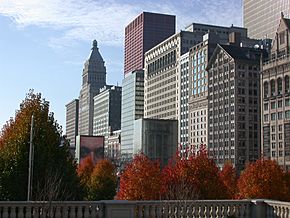Historic Michigan Boulevard District facts for kids
| Michigan Avenue | |
 |
|
| Maintained by | Department of Streets & Sanitation |
|---|---|
| Location | Chicago |
| North end | 150 North at Randolph Street |
| Major junctions |
Monroe Street/Drive Jackson Blvd./Drive Ida B. Wells Dr. from/to Eisenhower Expressway Balbo Drive |
| South end | 1100 South/1200 South at Roosevelt Road |
The Historic Michigan Boulevard District is a special part of Chicago in the area called the Loop. It includes Michigan Avenue between 11th Street (or Roosevelt Road) and Randolph Street. This area is named after the nearby Lake Michigan. On February 27, 2002, it was officially named a Chicago Landmark, which means it's a very important historical place.
Many famous buildings stand along Michigan Avenue, facing Grant Park. This part of Michigan Avenue is also known as the official end point of U.S. Route 66, a famous road across America. This district is one of the world's most famous "one-sided streets," like Fifth Avenue in New York City. It's just south of the Michigan–Wacker Historic District and east of the Loop Retail Historic District.
Contents
History of Michigan Avenue
Michigan Avenue gets its name from Lake Michigan. It used to run right next to the lake. But then, new land was created for Grant Park (which was once called Lake Park). This pushed the shoreline further east. The reason Michigan Avenue is a "one-sided street" (meaning buildings are only on one side) is thanks to Aaron Montgomery Ward. He fought legal battles with the city to keep Grant Park open and free of most buildings.
Ward believed that Grant Park should not have public buildings along the lakefront. The only exception he made was for the Art Institute of Chicago Building. Later, his ideas were used by Daniel Burnham in his famous Plan of Chicago. This plan aimed to make sure the buildings along Grant Park always had "light, air, and a nice view." Keeping this lakefront view has inspired architects to create many different and beautiful building designs along this "streetwall."
Today, Michigan Avenue is not officially called Michigan Boulevard. However, before the Great Chicago Fire in 1871, it was known as Michigan Boulevard. People often called it "Boul Mich." Even in the 1920s, North Michigan Avenue (especially the Magnificent Mile) was sometimes called "Upper Boul Mich." The original "Boul Mich" is actually Boulevard Saint-Michel in Paris.
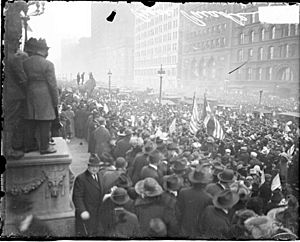
The district has changed a lot over the years. New building styles have been added. Between 1909 and 1910, the boulevard was made wider. This meant the famous lion statues at the entrance of the Art Institute of Chicago Building had to be moved back 12 feet. At that time, the intersection of Jackson Boulevard and Michigan Avenue was known as "route center" because it was the end of Route 66. Back then, no streets crossed Michigan Avenue and went eastward. So, the Jackson intersection was a "T" shape.
This was still true in 1920 when the Michigan Avenue Bridge opened. This bridge connected Michigan Avenue to the Magnificent Mile and areas north of the Chicago River. This greatly increased traffic. The Fountain of the Great Lakes, installed in 1913, was very easy to see from "route center." Today, four streets cross Michigan Avenue within the district. Two of them change names as they cross: East Monroe Street becomes East Monroe Drive, and East Jackson Boulevard becomes East Jackson Drive. East Ida B. Wells Drive and East Balbo Drive do not change names.
Michigan Avenue Today
Today, the only building on the eastern side of Michigan Avenue in the Historic District is the Art Institute of Chicago. However, some interesting structures have been added to the northern part of the eastern side in Millennium Park. These include the Crown Fountain and McCormick Tribune Plaza. The current "End Historic US 66" sign is now located along Michigan Avenue in this district. It marks the official end of U.S. Route 66 in Illinois. This sign and others are within Grant Park because new land was created, making two blocks of space between Michigan Avenue and Lake Michigan. Also, the Fountain of the Great Lakes was moved and is no longer easily seen from Michigan Avenue.
One current issue is the trend to build tall towers behind the old fronts (facades) of historic buildings. This is happening along Michigan and Wabash Avenues. Examples include The Heritage at Millennium Park and Legacy at Millennium Park. There's also a plan for an 80-story tower behind the YWCA building. This trend is putting the Chicago Athletic Association Annex at risk. Some want to tear it down for a new condominium tower. Because of this, the building was put on the "Chicagoland Watch List" in 2006-07 by the Landmarks Preservation Council of Illinois.
On the other hand, some people worried that making the area a landmark district would stop new building projects. But the goal of the landmark status is to "keep the architecture there and encourage architecture like it." So, buildings being updated for new uses, like condos and dormitories, are part of the district's present and future.
Important Buildings in the District
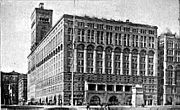
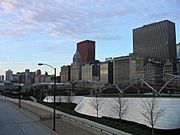
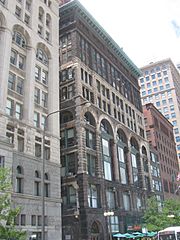
Several buildings in this district have played a big role in Chicago's culture and history.
The Blackstone Hotel is famous in Chicago. Chicago has hosted more United States presidential nominating conventions (26) than any other two American cities combined. The Blackstone Hotel has welcomed almost every U.S. President from the 20th century. It even gave us the phrase "in a smoke-filled room" for American politics.
The Chicago Symphony Orchestra first performed on October 16, 1891. Their first home was the Auditorium Theatre. They moved to Orchestra Hall in 1904. Theodore Roosevelt gave his famous Bull Moose speech here in 1912. He was nominated for President by the independent National Progressive Party. The Auditorium has also hosted famous musicians like Jimi Hendrix, The Who, and the Grateful Dead. The Auditorium Building is seen as a very important step in how modern architecture developed.
The Chicago Cultural Center is the city's official place for welcoming important guests. The Mayor of Chicago has welcomed Presidents, royalty, and diplomats here. In 2004, it was the eighth most-visited cultural place in Chicago, with 767,000 visitors. Inside, you can see beautiful mosaics, marble, bronze, and stained-glass domes. These were designed by the Tiffany Glass and Decorating Company.
The Art Institute of Chicago is a famous fine-art museum. It is well known for its Impressionist and American art collections.
See also
 In Spanish: Distrito Histórico de Michigan Boulevard para niños
In Spanish: Distrito Histórico de Michigan Boulevard para niños



